Ashur › Philip II of Macedon » Ancient origins
Articles and Definitions › Contents
- Ashur › Ancient History
- Philip II of Macedon › Who Was
Ancient civilizations › Historical and archaeological sites
Ashur › Ancient History
Definition and Origins
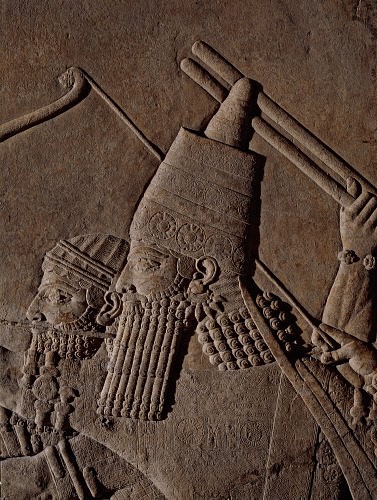
Ashur (also known as Assur ) was an Assyrian city located on a plateau above the Tigris River in Mesopotamia (today known as Qalat Sherqat, northern Iraq). The city was an important center of trade, as it lay squarely on a caravan trade route that ran through Mesopotamia to Anatolia and down through the Levant. It was founded c. 1900 BCE on the site of a pre-existing community that had been built by the Akkadians at some point during the reign of Sargon the Great (2334-2279 BCE) of Akkad.
According to one interpretation of passages in the biblical Book of Genesis, Ashur was founded by a man named Ashur son of Shem, son of Noah, after the Great Flood, who then went on to found the other important Assyrian cities. A more likely account is that the city was named Ashur after the deity of that name sometime in the 3rd millennium BCE; the same god's name is the origin for Assyria. The biblical version of the origin of Ashur appears later in the historical record after the Assyrians had accepted Christianity and so it is thought to be a re-interpretation of their early history which was more in keeping with their new belief system.
Because of the lucrative trade Ashur enjoyed with the city of Karum Kanesh in Anatolia, it flourished and became the capital of the Assyrian Empire. Even after the capital was moved to the cities of Kalhu ( Nimrud ), then Dur-Sharrukin, and finally Nineveh, Ashur continued to be an important spiritual center for the Assyrians. All of the great kings (except for Sargon II, whose body was lost in battle ) were buried at Ashur, from the earliest days of the Assyrian Empire down to the last, no matter where the capital city was located.
ALL THE GREAT ASSYRIAN KINGS BUT ONE WERE BURIED AT ASHUR, NO MATTER WHERE THE CAPITAL CITY WAS LOCATED.
EARLY HISTORY
Archaeological excavations show that a city of some sort existed at the site as early as the 3rd millennium BCE. What precise form this city took is not known nor is its size. The oldest foundations discovered thus far are those beneath the first IshtarTemple, which probably formed the base for an earlier temple as the Mesopotamians generally built the same sort of structure on the ruins of an earlier one.
From pottery and other artifacts found in situ, it is known that Ashur was an important center of trade early in the Akkadian Empire and had been an outpost of the city of Akkad. In time, trade between Mesopotamia and Anatolia increased, and Ashur was among the most important cities in these transactions owing to its location. Merchants would send their wares via caravan into Anatolia and trade primarily at Karum Kanesh. The scholar Paul Kriwaczek writes:
For several generations the trading houses of Karum Kanesh flourished, and some became extremely wealthy – ancient millionaires. However not all business was kept within the family. Ashur had a sophisticated banking system and some of the capital that financed the Anatolian trade came from long-term investments made by independent speculators in return for a contractually specified proportion of the profits. (214)
These profits were spent largely in the city on renovations and modifications to private homes and public buildings. Through trade, Ashur prospered and expanded, becoming the capital of Assyria by the second millennium BCE. Walls were built around the city to enhance its natural defenses, even though these defenses were quite advantageous on their own. Regarding this, the historian Gwendolyn Leick writes:
The city of Ashur was built on a rocky limestone cliff that forced the fast-flowing Tigris into a sharp curve. The main stream was also joined by a side-arm in antiquity, so that an oval-shaped island was created with a shoreline of 1.80 kilometres (1.1 miles). Rocky outcrops rose some 25 metres (82 feet) above the valley floor, with steep sides. This naturally sheltered position had strategic importance as it made the site comparatively easy to defend, besides forming a landmark with a wide view over the valley. (194-195)
THE RISE OF ASHUR
As the city flourished, the Assyrians expanded their territory outwards. The Assyrian king Shamashi Adad I (1813-1791 BCE) drove out the invading Amorite tribes and secured the borders of Ashur and Assyrian land against further incursions. The city grew under the reign of Shamashi Adad I and then fell to the might of Babylon under Hammurabi (1792-1750 BCE).
Hammurabi treated Ashur well and respected the gods and the temples but no longer permitted the city to trade with Anatolia.Babylon took over the trade route that had made Ashur wealthy, and the Assyrian city was forced to trade only with Babylon;this caused a decline in the prosperity of Ashur and it languished as a vassal state.
When Hammurabi died in 1750 BCE, the region erupted in turmoil and civil war as city-states competed with each other for control. Stability was finally achieved by the Assyrian king Adasi (1726-1691 BCE) but, by that time, the kingdom of Mitannihad grown up in western Anatolia and slowly spread through Mesopotamia, now holding Ashur as part of its territory. Ashur again languished as a vassal state until the rise of the Assyrian king Ashur-Ubalit I (1353-1318 BCE) who defeated the Mitanni and took large portions of their territory.
The Kingdom of Mitanni had suffered significant losses since the days of its prime, ever since the Hittite king Suppiluliuma I(1344-1322 BCE) conquered them and replaced Mitanni rulers with Hittite officials. Ashur-Ubalit I defeated these Hittite rulers in combat but could not dislodge their hold on the region completely. The later king Adad Nirari I (1307-1275 BCE) conquered the Hittites and took the lands of the Mitanni to create the first semblance of an Assyrian empire.
Ruling from Ashur, he led his victorious army throughout the region and sent the loot from his conquests back to the city. Ashur was again prosperous and began again to develop and expand. Adad Nirari I commissioned many building projects in the city and improved the walls. It is from this point on that Ashur becomes the city of note made famous as the capital of the Assyrian Empire.
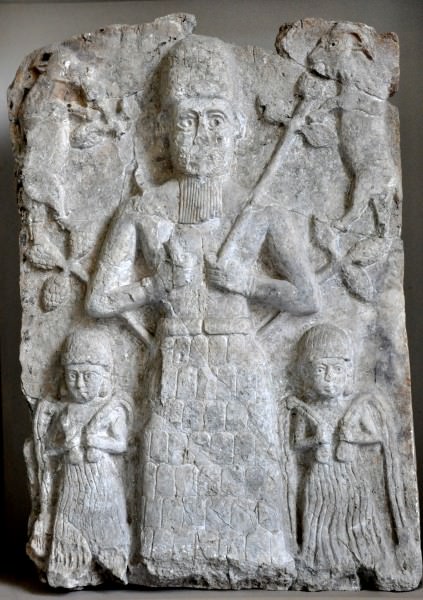
A cult relief from Ashur
ASHUR THE CAPITAL
Adad Nirari I's son, Shalmaneser I (1274-1245 BCE), continued improvements on the city and was so prosperous that he was also able to build the city of Kalhu (also known as Nimrud, which would later become the capital). His son, Tukulti-Ninurta I(1244-1208 BCE), took renovations and building projects even further. Tukulti- Ninurta I built his own city, called Kar-Tukulti-Ninurta (Harbor of Tukulti-Ninurta) across the river from Ashur.
For some time now, historians have claimed that this city was built after Tukulti-Ninurta I's sack of Babylon in c.1225 BCE because of inscriptions found at the site which seemed to support this version of history. It is now thought, based on other inscriptions and records and archeological evidence at the site, that the king began building his city early in his reign. His reasons for doing so could have been that there was little left to improve on in the city of Ashur and he wanted some impressive building project that would separate his name from that of his predecessors.
He had already renovated the Temple of Ishtar in Ashur and commissioned other projects but these were simply improving upon what the earlier kings had accomplished. As Tukulti-Ninurta I was an ambitious man with a grand vision of himself, only the construction of a completely new city bearing his name seemed to suit his purposes. Although Kar-Tukulti-Ninurta was earlier thought to have been built as the new capital to replace Ashur, this theory is no longer accepted by many historians.
Records indicate that the same officials who worked in the palace at Ashur also worked across the river in Kar-Tukulti-Ninurta at the same time, suggesting that business continued as usual in the capital city. Tukulti-Ninurta I clearly favored his new city, however, since he seems to have lavished the wealth he plundered from the temples of Babylon on his new palace and other projects in Kar-Tukulti-Ninurta. The king was assassinated in his palace by his son because of his treatment of Babylon and, especially, the sack of the temples; after his death, his city was abandoned in favor of Ashur and eventually decayed and collapsed.
Ashur continued as the capital and jewel of the empire into the later reign of Tiglath Pileser I (1115-1076 BCE) who issued his famous law code from the city and lavished his wealth on improvements to the palace and walls. Like his predecessors, he campaigned with his troops throughout the region and expanded Assyrian territory significantly but, after his death, the kingdom he had built fell apart. Ashur during this time remained stable, if not especially prosperous, and the kings who followed Tiglath Pileser I were able to retain the lands surrounding the city, even though they lost regions further away.
With the rise of Adad-Nirari II (912-891 BCE), the city again enjoyed its former prosperity and the Assyrian Empire began to rise. Adad-Nirari II re-conquered the regions that had slipped from Assyrian control and expanded the empire further in every direction. Ashur was now the hub of the giant wheel of empire, and wealth regularly flowed into the capital from the military campaigns of the kings.
The Assyrian policy of deporting and re-locating large segments of the population of conquered regions also impacted Ashur in that scribes and scholars were regularly sent there to work in the library, palace, or in the schools. This helped to make Ashur a center of learning and culture. When Tukulti-Ninurta I sacked Babylon, part of the loot he brought back to Ashur was books.The clay tablets upon which the stories and myths and legends of Babylon were written now filled the shelves of Ashur's library and, as they were copied by the scribes, influenced Assyrian writers and were also preserved for the future.
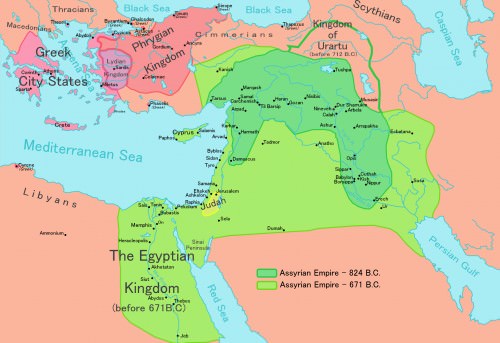
Neo-Assyrian Empire
ASHUR IN THE NEO-ASSYRIAN EMPIRE
The king Ashurnasirpal II (884-859 BCE) moved the capital from Ashur to Kalhu, but this had no effect on the prosperity or importance of Ashur. Kalhu was renovated following Ashurnasirpal II's successful campaigns, and he most likely made it his capital for the same reason Tukulti-Ninurta I built his city: to elevate his name above his predecessors. The historian Marc Van De Mieroop writes:
The kings must have had a motivation for the building of these vast cities, but when we look at their records no reason for the work is declared. Ashurnasirpal's justification for the work on Kalhu is merely a statement that the city built by his predecessor Shalmaneser had become dilapidated. (55)
There is also no reason stated for making Kalhu the new capital, and this move seems particularly strange when one considers the natural defenses of Ashur and the strength of its walls. One suggested theory is that Ashurnasirpal II wanted a virgin city whose populace had no cohesive identity. Ashur, by this time, was a very prestigious city and its citizens prided themselves on their city and being Ashurians. It has therefore been proposed that Ashurnasirpal II moved the capital in order to create a royal power base with a less proud, and therefore more easily managed, population.
A stele found in the ruins of Kalhu describes the inauguration festival of the new capital at which Ashurnasirpal II fed 69,574 men and women from his kingdom for ten days. Other inscriptions in the city tell of how Ashurnasirpal II referred to Kalhu as “my royal dwelling and for my lordly pleasure for all time” and how he planted saplings of 41 types of trees around the new city and dug massive canals and irrigation ditches (Van De Mieroop, 68). All of this was done to elevate the new capital city above Ashur, and yet there is no evidence of any decline in Ashur's status throughout the next 150 years in which Kalhu was the capital.
Ashur was successfully defended during the civil wars which marked the reign of Shamshi Adad (824-811 BCE) and was renovated under the kings who followed him. Tiglath Pileser III (745-727 BCE further enriched the city and strengthened the walls and his successors would do likewise. Sennacherib (705-681 BCE) brought the spoils of his sack of Babylon back to Ashur even though, by that time, Nineveh was the capital city and the site of his palace “without rival”. He clearly poured this wealth into the gardens, parks, and the palace at Nineveh but continued to honor the ancient city of his ancestors.
The kings who followed him, Esarhaddon (681-669 BCE) and Ashurbanipal (668-627 BCE), also honored the city with gifts and building projects. When Ashurbanipal died, the regions of the Assyrian Empire rose in revolt and the empire began to break apart. Ashurbanipal's successors could do nothing to stop the rapid decline and the empire fell.
The city of Ashur was destroyed in 612 BCE by the combined forces of the Babylonians, Medes, and Persians, along with the other great Assyrian cities such as Nineveh. The city lay in ruin but was re-populated and partially re-built at some point. Ashur continued as a settlement up through the 14th century CE but would never again be as prosperous as it had been during its golden age.
MAP
Philip II of Macedon › Who Was
Definition and Origins
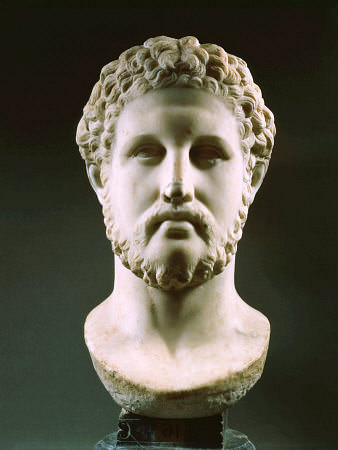
Although he is often only remembered for being the father of Alexander the Great, Philip II of Macedon (reigned 359 BCE - 336 BCE) was an accomplished king and military commander in his own right, setting the stage for his son's victory over Darius III and the conquest of Persia. Philip inherited a weak, backward country with an ineffective, undisciplined army and molded them into a formidable, efficient military force, eventually subduing the territories around Macedonia as well as subjugating most of Greece. He used bribery, warfare, and threats to secure his kingdom. However, without his insight and determination, history would never have heard of Alexander.
Unlike many of the city -states in Greece, Macedonia was a monarchy, seen as primitive and backward by the rest of Greece.Although the people spoke a Greek dialect, many believed the country was useful only as a source of timber and pastureland.The royal family of this barbaric land was the Argeads who traced their roots to both the isle of Argos and Heracles ( Hercules), the son of Zeus. Born around 383 BCE, Philip was the youngest of the three sons of Amyntas III. His older brother Perdiccas III was killed while fighting the Illyrians along the northern Macedonian border. Since the oldest Argead brother, Alexander II, was also dead, Philip was made regent for his nephew Amyntas IV. Philip assumed the Macedonian throne for himself at the age of 23 in 359 BCE. His immediate concern was twofold: to safeguard Macedonia's borders and reorganize the army. His major foes were the Illyrians (whom he would eventually defeat in 359 BCE) and the Athenians. who not only possessed nearby gold and silver mines but also supported a pretender to the Macedonian throne. Luckily, since much of Greece was embroiled in a series of civil wars, Philip had time to address Macedonia's most pressing concern.
WITHOUT PHILIP'S INSIGHT AND DETERMINATION, HISTORY WOULD NEVER HAVE HEARD OF ALEXANDER THE GREAT.
Philip quickly realized the weaknesses of his country's army and drew upon past experience to mold them into a superb fighting unit. For three years, beginning around 367 BCE, he had been a hostage in Thebes - his brother Perdiccas eventually gained his release - where he witnessed the infamous Sacred Band and the extremely successful Theban wedge, as well as the tactical abilities of their famed commanders Epaminondas and Pelopidas. Using these experiences, he completely reorganized Macedonia's army. He increased its size from 10,000 to 24,000 and enlarged the cavalry from 600 to 3,500. This was no longer an army of citizen-warriors but one of professional soldiers. He created a corps of engineers to develop siege weaponry, namely towers and catapults. To give each man a sense of unity and solidarity, he provided uniforms and required an oath of allegiance to the king: each soldier would no longer be loyal to a particular town or province but faithful only to the king. Next, he restructured the traditional Greek phalanx, providing each individual unit with its own commander, thereby allowing for better communication. Philip changed the principal weaponry from the hoplite spear to the sarissa, an 18 to 20 feet pike; it had the advantage of reaching over the much shorter spears of the opposition. Besides the sarissa, a new helmet, and a redesigned shield, each man possessed a smaller double-edge sword, or xiphos, for close-in-hand fighting.
After his reorganization of the army, he remade the capital city of Pella, inviting poets, writers, and philosophers; Aristotlewould be asked to teach Philip's son Alexander. Again, his reasoning was sound: to assure that his neighbors would not attack, he invited their sons to Pella to not only be educated but also to serve as hostages. In order to safeguard his authority at home, he established the Royal Pages to secure the throne against possible plots. However, his primary concern remained the safety and security of Macedonia. In 357 BCE he angered the citizens of Athens when he captured their colony at Amphipolis, thereby acquiring its gold and silver mines. He would temporarily return it to the city-state only to recapture it later. From there, he seized the northern Greek cities of Potedia and Pydna in 356 BCE.
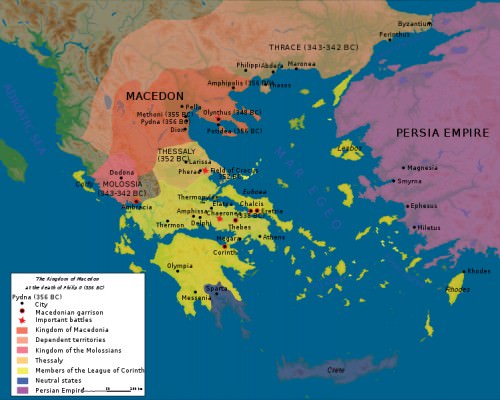
Macedonia under Philip II
Philip's power would come to fruition when he became involved in the Third Social War in 356 BCE. The Phocians had seized the city of Delphi, home of the famed oracle. Both Athens and Sparta entered the conflict on the side of the Phocians. The Thessalian League asked Philip to help and, although he was initially defeated, he and the Thessalian cavalry crushed the Phocians and their commander Onomarchus at the Battle of Crocus Field in 352 BCE. Although unable to secure alliances against Philip, Athens would continue to wage war until the Peace of Philocrates in 346 BCE. This constant warfare further weakened southern Greece. During this time, Philip expanded his hold on Greece by capturing the cities of Crenides in 355 BCE, a city he renamed Philippi ; Methone in 354 BCE which he razed; and Olynthus on the Chalcidice peninsula in 348 BCE. But he did not escape these battles without some personal scars - a lost eye, a broken shoulder, and a crippled leg.
Throughout Philip's rise to power and his victories throughout Greece, a constant thorn in his side was Demosthenes, the great Athenian orator, who constantly railed against Philip in a series of speeches called The Philippics. His fiery speeches - he would later call Alexander a brat - eventually culminated in the Battle of Chaeronea in 338 BCE, a battle that demonstrated both the power and authority of Macedonia. Philip and his son Alexander (only 18 at the time) soundly defeated the combined forces of both Athens and Thebes. Eventually, a PanHellenic Congress was summoned at Corinth (Sparta would not attend) and peace was finally established. With his establishment as the head of the Congress and his promise to secure the Greek colonies in Ionia, Philip began to plan for his invasion of Persia.
During his conquest of Greece, Philip took time away from the battlefield to marry seven times. The most famous of these marriages was to Olympias, daughter of Neoptolemus of Epirus and mother of the future conqueror of Persia, Alexander (there was also a daughter named Cleopatra ). At the time of Alexander's birth in 356 BCE, Philip was away in battle at Potidea. The historian Plutarch in his Life of Alexander wrote of this time, “Just after Philip had taken Potidea, he received three messages at one time, that Parmenio had overthrown the Illyrians in a great battle, that his race-horse had won the course at the Olympic Games, and that his wife had given birth to Alexander ….” However, as Alexander grew and his intelligence became obvious, tension rose between father and son. Because Alexander's mother was from neighboring Epirus, the king was pressured to marry a true Macedonian and provide the country with a pure-blood heir.
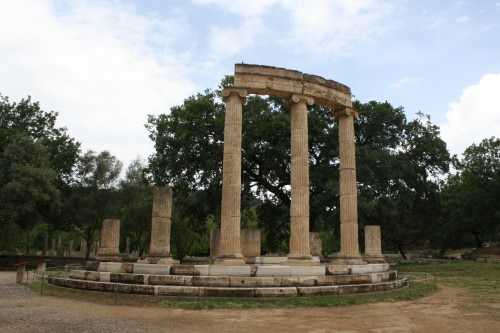
The Philippeion of Olympia
In 337 BCE Attalus, a close friend and Macedonian commander, convinced Philip to marry his niece, Cleopatra Eurydice, and provide a more suitable heir. Plutarch wrote, “At the wedding of Cleopatra, whom Philip fell in love with and married, she being much too young for him, her uncle Attalus in his drink desired the Macedonians would implore the gods to give them a lawful successor to the kingdom by his niece.” At the wedding banquet, Alexander became incensed at this idea and voiced his outrage, both at Attalus's comments and his father's drunkenness. Because of his remarks, he and his mother were both temporarily exiled - she in Epirus and he in Illyria. Shortly after his return to Pella, Alexander would be sitting on the throne.
In 336 BCE a former friend and lover of Philip, Pausanias, became angry with Philip over a personal matter and stabbed him to death. Alexander was quickly crowned as the king. Plutarch wrote, “… Pausanias, having had an outrage done to him at the instance of Attalus and Cleopatra, when he found he could get no reparation for his disgrace at Philip's hands, watched his opportunity and murdered him. The guilt of which fact was laid for the most part upon Olympias, who was said to have encouraged and exasperated the enraged youth to revenge …” Olympias' supposed part in the assassination has never been proven; however, it was widely known that she had always wanted the throne for Alexander. Philip's new wife and child were quickly put to death by Olympias, eliminating any significant claimant to the throne. After subduing any serious threats to his rule, Alexander fulfilled his father's dream and invaded Persia.
LICENSE:
Article based on information obtained from these sources:with permission from the Website Ancient History Encyclopedia
Content is available under License Creative Commons: Attribution-NonCommercial-ShareAlike 3.0 Unported. CC-BY-NC-SA License